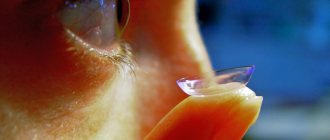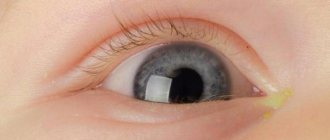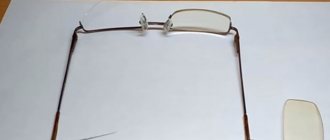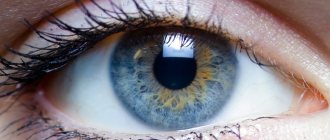A chemical eye burn is an emergency that requires immediate medical attention. It is important to properly cleanse the mucous membrane of the irritant in order to achieve complete healing in the future. You need to know how to properly provide first aid for an eye burn with chemicals, so as not to worsen the damage.
How can you burn your eyes?
Most often, chemical burns to the eyes occur at work. You can injure the mucous membrane at home if you do not follow safety precautions when using household chemicals, lime, and ammonia. Even if a small amount of the substance is used, gloves and special safety glasses must be worn. Regular glasses do not adhere to the skin and leave pathways for irritants to enter.
Eye burns can occur during eyelash extensions. The glue used in the salon is a strong irritant. Contact with it causes swelling, itching, burning, redness and pain.
Chemical burns to the eye are a common consequence of using a gas spray for self-defense. Upon contact with an irritant, blepharospasm may occur, that is, the eye will close abruptly and will not open. Usually the spasm lasts for an hour if the eye is not washed out in time. It is recommended to blink for 5 minutes after rinsing to restore muscle function.
What should be done for subsequent treatment after first aid?
Upon admission to the ophthalmology department with a complaint of a chemical burn to the eyeball, be prepared to be repeatedly rinsed with saline and treated with anti-inflammatory ointments.
You will also need to undergo a series of diagnostic tests for:
- Assessment of the degree of burn to the eyeball.
- Assessment of the level of mucosal damage.
- Checking the preservation of visual acuity.
Keep in mind! To treat a burn at home, doctors most often prescribe the following groups of medications:
- Preparations to accelerate local regeneration of eyeball tissue: drops, ointments, etc.
- Painkillers – for internal and external use.
- Anti-inflammatory drugs - rinsing solutions, ointments, drops.
- Antibiotics – if an inflammatory process is suspected.
Degree of eye burn
Almost all chemicals can irritate the mucous membranes of the eye, but serious damage occurs upon contact with strong alkalis and acids. Alkali burns occur most often, but they are also the most dangerous, especially with bilateral damage. Often such injuries result in visual impairment.
The severity of a chemical burn will depend on the volume, temperature and concentration of the irritant, duration of exposure and degree of penetration. In some circumstances, the person's age is also important: in general, children tend to have more severe burns.
There are four degrees of eye burn, but the mechanism of damage by alkalis and acids is different. The initial assessment of burn severity is based on the degree of corneal transparency and the severity of ischemia (blanching).
Degree of eye burn:
- First degree (favorable prognosis). It is characterized by the absence of ischemia and the transparent state of the cornea.
- Second degree (good prognosis). Ischemia affects a third of the limbus, there is clouding of the cornea, but details of the iris are visible.
- Third degree (ambiguous prognosis). There is clouding of the corneal stroma, the epithelium is completely lost, ischemia from a third to half of the limbus masks the details of the iris.
- Fourth degree (poor prognosis). Ischemia affects most of the limbus, and there is total opacification of the cornea.
Additionally, the filling of limbal vessels is considered. When determining the degree, the extent of destruction of the corneal epithelium, the presence of symptoms of conjunctivitis, the condition of the lens and iris, as well as indicators of intraocular pressure are also taken into account.
Features of burns with acids and alkalis
Eye burns from sulfuric acid are not as dangerous as from alkali. This is due to the fact that a film of coagulated protein forms on the eye when the irritant reacts with the mucous membrane. The film does not allow acid to penetrate deep into the eye, protecting the eye from deep damage. However, coagulation does not protect against complications if a concentrate of nitric and hydrofluoric acids gets into the eyes. An acid burn is characterized by severe pain, and sometimes even painful shock.
It is noteworthy that when the eye is damaged by alcohol, a person experiences severe pain, but minimal damage is noted. However, alcohol can absorb moisture from the lubricating fluid and the eyeball, penetrating deep into and damaging the cornea and lens. If washed in a timely manner, there will be no consequences for vision.
The most dangerous are alkali burns. In this case, there is severe dehydration and cell destruction. Alkalies provoke the decomposition of protein structures, wet necrosis develops, and when the irritant gets into the intraocular fluid, the deep structures of the eye are affected. Alkali can reach the corneal stroma and trabecular meshwork. As a result, the cornea becomes cloudy and intraocular pressure increases.
Common symptoms of a chemical burn
- Deterioration of vision. The initial decrease in visual acuity is caused by epithelial defects, increased lacrimation, clouding and discomfort. Even with moderate to severe burns, vision may be preserved if the corneal clouding is minor, but severe deterioration will occur over time.
- Fragments of the irritant in the arches of the outer shell. Residues of foreign matter are visible when plaster and other solid irritants enter the eye. The fragments must be removed immediately, otherwise they will continue to release toxins and worsen the damage. Only after cleansing the eye does the natural recovery process begin. Carbide and lime are the most dangerous because they dissolve in the tear and cause severe damage. If these substances come into contact, do not delay cleansing.
- Increased intraocular pressure. A sharp increase in pressure occurs due to deformation and contraction of collagen fibers in the anterior part of the eyeball. Subsequently, the increase is associated with inflammation.
- Inflammatory process in the conjunctiva. Even with mild damage, swelling and redness of the mucous membrane is noted. Sometimes when a burn occurs, the color of the conjunctiva changes (brown when damaged by chromic acid, yellowish when exposed to nitric acid).
- Perilimbal ischemia. Based on the degree of blanching, one can make a prediction about the restoration of the cornea, because limbal sprout cells restore the epithelium. Severe ischemia indicates an unfavorable course of the process.
- Cloudiness. If the cornea is transparent, a zero degree of damage is determined, and if the cornea is completely clouded, the fifth degree is determined. Complete stromal opacification makes it impossible to examine the anterior chamber of the eye.
- Defects of the corneal epithelium. Damage to the cornea can be expressed as diffuse punctate keratitis or complete absence of the epithelium. In the latter case, the defect is poorly stained with fluorescein and may not be diagnosed. If the epithelial defect is not visible during the initial examination, prompt re-examination is recommended.
- Corneal perforation. The symptom appears a few days after a severe eye burn, when the cornea's ability to regenerate decreases.
- Inflammation in the anterior region. The reaction may affect single cells or have a pronounced fibrinoid form. Inflammation is more pronounced when alkali gets into the eye, since these substances can penetrate deep into the structures.
- Scarring or other damage to the conjunctiva and eyelids. The symptom may be a problem if scarring prevents the palpebral fissure from closing.
Brake Fluid Danger
Brake fluid contains chemical composition similar to those found in antifreeze. Therefore, it is not surprising that any DOT 3/DOT 4 brake fluid, according to the same safety data sheet, contains a number of warnings for humans about the toxicity of the product.
For example, all brake fluid manufacturers indicate in their product safety data sheets that the fluid can cause eye damage, skin irritation, etc. reactions. If brake fluid enters the human body, it can cause kidney and liver damage.
Here is a description from the safety data sheet for Shell Brake & Clutch Fluid DOT 4 ESL:
Does not pose a health hazard under normal conditions of use.
If inhaled: Remove victim to fresh air. If symptoms persist, immediately take the victim to a hospital for additional medical care.
After skin contact: Remove contaminated clothing. Wash the exposed area with running water, followed by soap and water, if available. If irritation persists, seek medical attention.
If in eyes: Immediately flush eyes with large quantities of water for at least 15 minutes, keeping eyelids open. Take the victim to the nearest medical facility for medical attention.
If ingested: If swallowed, do not induce vomiting: take the victim to the nearest medical facility for further medical attention. In case of spontaneous vomiting, keep the victim's head below hip level to prevent vomit from entering the respiratory tract with inhaled air.
What to do if you have a chemical burn to the eye
Before providing first aid, you need to transfer the victim to a dark room to minimize the effect of light on the eyes and relieve pain. Folk remedies for chemical eye burns are ineffective, and some can be dangerous. Do not wash your eyes with tea or herbal infusion. It is not recommended to refuse the help of doctors in favor of traditional medicine.
First aid for a chemical burn to the eye:
- Remains of the substance are removed from the eyelids with a cotton swab.
- The eyes are rinsed generously under running water for 15 minutes. It is recommended to additionally wash alkaline burns with a 2% boric acid solution, and acid burns with a soda solution.
- If there is severe pain, the patient should be given an effective pain reliever.
- Instill a 4% solution of novocaine or lidocaine, or a 0.2% solution of chloramphenicol.
- Use a disinfectant (0.25% Levomycetin, Sebizone, Albucid-sodium, Acetopt, Ophthalmite, Gentamicin drops).
Rinsing should last more than 15 minutes. You can use clean water, sodium chloride solution (0.9%) or a weak solution of potassium permanganate. If it is not possible to use a special solution, tap water can be used. Potential infection in the long term is not as dangerous as long-term poisoning from the remnants of the irritant.
Emergency help
There are 4 degrees of damage for chemical burns of the eye with acid and alkali. Help needs to be provided as quickly as possible. This will minimize damage and improve the prognosis for recovery.
- First of all, you need to rinse the affected area. This must be done no later than half an hour after injury.
- You will need saline solution, potassium permanganate slightly diluted in water, or 0.9% sodium chloride solution. You can use regular cool water.
- The procedure should be carried out for 20 minutes, washing the mucous membrane from the inner corner of the eye to the outer.
- If the cause of the burn is a solid substance, you must first remove it with tweezers or a sterile cloth..
- To provide qualified emergency care, it is important to find out what exactly caused the injury, because the effect of chemicals can be neutralized.
- When alkali gets into the eye, rinsing should be done with a three percent acetic solution or two percent boric acid.
- Acid burns should be washed with a solution of baking soda - 25 g of the substance is dissolved in 0.5 liters of water.
To prevent the development of infection, you can instill a solution of Furacilin. Then you should cover the eye with sterile gauze, secure it with a bandage and go to the hospital. It is advisable to take with you a bottle of the reagent that caused the injury. Studying the contents will help doctors prescribe the right therapy.
Treatment of chemical burns to the eye
The entire process of treating a chemical burn can include both conservative and surgical methods. The main thing is to preserve vision. Patients with severe burns need to be hospitalized immediately. In case of damage to degrees I and II, it is advisable to consult a doctor after providing first aid and follow all recommendations at home.
Stages of treatment for chemical eye damage:
- Removing the irritant. The most important step in emergency care for chemical burns is copious rinsing. If possible, the eye should be anesthetized before rinsing. Local anesthesia reduces pain and blepharospasm. It is advisable to use a sterile buffer solution (normal saline or Ringer's solution).
- Control of the inflammatory process. At the time of damage, inflammatory mediators are released, which provoke necrosis. This process inhibits re-epithelialization and increases the risk of ulcers and corneal perforation. You can interrupt the inflammation with the help of local steroids; citrate or ascorbic acid is additionally prescribed. To inhibit collagenosis and prevent ulcers, 10% or 20% Acetylcysteine is sometimes used.
- Acceleration of regeneration. Full epithelization begins only after the irritant is removed from the eye. Chemical damage causes a temporary increase in tear production and a decrease in future tear production, so it is important to use moisturizers for healing. Ascorbic acid helps restore collagen structure and accelerate corneal regeneration. In some cases, wearing therapeutic bandage lenses is recommended.
Since chemical burns to the eyes are accompanied by severe pain, the victim is prescribed powerful anesthetics. Additionally, anti-inflammatory drugs and drugs that prevent the formation of adhesions are used. Treatment of burns usually begins with tetanus vaccination.
Glucocorticosteroids
If severe inflammation develops with a corneal burn, doctors prescribe glucocorticosteroids:
- Dicaine. Eye drops with leocaine and sodium chloride have a local anesthetic effect, relieve pain and prepare the cavity before surgery. The dosage is determined by the degree of burn.
- Ciprofloxacin. The ophthalmic drug is available in the form of drops or ointment, but in case of a burn, the use of a solution is recommended. Ciprofloxacin has antibacterial and anti-inflammatory effects. The drug is instilled every 15 minutes for the first 6 hours, then every half hour the next day. On days 3-14, the interval is increased to 4 hours. Ciprofloxacin is only allowed in patients over 1 year of age.
- Atropine. For chemical burns to the eyes, this remedy helps reduce pain and prevent adhesions. The active ingredient is atropine sulfate. The drug is instilled three times a day, 1-2 drops.
- Diacarb. The drug in tablet form is prescribed for increased intraocular pressure. The effectiveness of Diacarb is due to the content of acetazolamide, magnesium stearate, povidone, croscarmellose sodium and other substances. Usually prescribed one tablet 3-4 times a day. Diacarb is contraindicated in diabetes mellitus, acute liver and kidney failure, uremia, hyponatremia, metabolic acidosis, hypokalemia, in the first trimester of pregnancy and during lactation. The drug is prescribed to patients over 3 years of age.
- Prednisolone. This glucocorticosteroid is taken only with the permission of a doctor. Usually prescribed one tablet per day. Prednisolone is contraindicated for fungal infections.
Although chemical burns require emergency treatment, the prognosis is often good. If the damage did not affect the deep structures of the eye, and the appropriate measures were carried out in a timely and correct manner, the preservation of vision will be ensured. In some cases, even immediate help does not prevent the formation of an eyesore. Even after successful treatment, scars may remain and affect the quality of vision.
Relieving pain from eye burns
A serious chemical burn does not occur without prolonged and severe pain. At the initial stage, oral analgesics are most often used. The spam of the ciliary muscle can be weakened with the help of cycloplegic drugs.
Prevention of secondary infection
If the burn has severely damaged the corneal epithelium, the risk of infection increases. At the initial stage of therapy, antibiotics are prescribed for prophylaxis. Minor, deep corneal injuries can be treated with cyanoacrylate eye glue.
Monitoring intraocular pressure
If elevated pressure levels are observed during a burn, blockers of the production of intraocular fluid are prescribed. Such drugs are indicated both at the initial stage of treatment and during late rehabilitation therapy. When elevated intraocular pressure persists even with the use of antihypertensive agents, surgical intervention (penetrating antiglaucoma or surgery with shunt or valve devices) is required.
Surgical treatment of eye burns and possible complications
If conservative methods are ineffective, surgical treatment of the consequences of the burn is performed. Depending on the complications, a variety of techniques are used.
Surgical treatment for an eye burn may include:
- partial removal of areas of necrosis of the conjunctiva or corneal surface;
- temporary covering with amniotic membrane;
- transplantation of limbal cells or cultured corneal epithelial cells;
- removal of the fusion of the conjunctiva of the eyelids with the eyeball (symblepharon).
To speed up rehabilitation, penetrating or partial keratoplasty and keratoprosthesis are used. If a cataract occurs, it is extracted.
Primary complications of a chemical burn include conjunctivitis, corneal erosion, swelling or clouding, acute increase in intraocular pressure, and melting of the cornea. Secondary complications are usually more varied.
Possible consequences of a chemical burn to the eye:
- glaucoma;
- cataract;
- scarring of the conjunctiva;
- corneal ulcers;
- thinning and tearing of the cornea;
- destruction of the corneal surface;
- opacification and vascularization;
- subatrophy of the eye.
The main measure to prevent burns is to follow safety precautions when working with household chemicals and in production where chemicals are used. It is important to exercise caution and wear safety glasses.
Sources used:
- Bloodstream of the ciliary body of the eye: monograph. / Alexey Pryakhin. - M.: LAP Lambert Academic Publishing, 2013.
- Introduction to clinical ophthalmology / E.E. Somov. - M.: Leningrad Pediatric Medical Institute, 1993.
- Vision problems from dry eye syndrome to macular degeneration. - M.: Art-Rodnik, 2011.
- International Council of Ophthalmology











